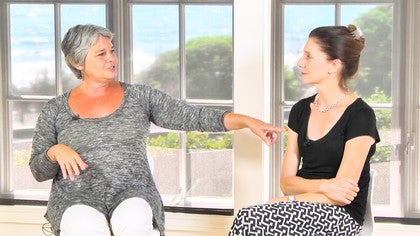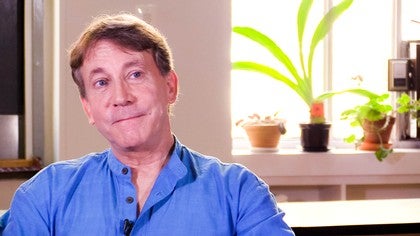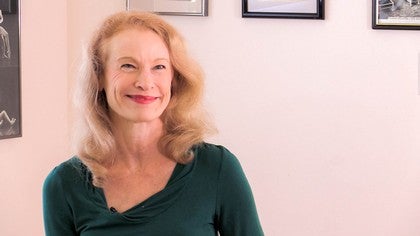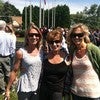Discussion #1315
Diane & Susan on Ron
Description
About This Video
Transcript
Read Full Transcript
I'm Diane Diffenderfer. Um, I am a former professional ballet dancer. Uh, currently I am a faculty member at the university of California Irvine. I teach dance, ballet, all levels of ballet and the dance department. And I conduct the palazzos program for our dance majors. Um, I also have a studio in Costa Mesa, California studio decor, the palati center of orange County.
And while it sounds like perhaps you know, what's wrong with you if you've been practicing is why do you have another knee problem? I think the real truth of the matter is that without the work that I've done on my body all these years, I would have had far worse problems with my knee, probably would have had this knee replacement a lot sooner. Um, apparently I'm the best student they have and the physical therapy clinic and I am religiously practicing all of my PyLadies work and the work that Ron taught me, the standing work, the balancing work is just been an integral part of my rehab for this latest knee repair. And so I look forward to the next chapter of my life with a really healthy body and great knees.
So when I became a dancer, I was in pretty good shape, but aches and pains and never really learned how to use my body. So I think when Ron Fletcher came to UCLA to teach, um, a master class, I thought, you know, this makes sense. This feels right. And, uh, having studied with Bella Lewicki, who's was what you could easily call the West coast, Martha Graham, what Ron was teaching was like home. So while I didn't have any specific injuries, I for the first time learned how to use my body efficiently. And um, I think, um, as Diane said, I saved myself from a lot of injuries and at 55, I move very easily. So I'm grateful for that. And that's the work.
So we went ahead, we did the ballet, we did, I think it went well. And then around the same time, Diane and Michael invited some of us to come to Ron studio to experience the plotters, work in the studio to try the equipment, take a mat class and this and that. So I went over there on my day off and I, that was my first exposure. Ron was not in the studio at that time. He was out and about doing some guests teaching elsewhere. But Diane and Michael took good care of me and, um, I was beginning to learn things. I had no idea what I was there for. I thought it was the strangest thing to work in parallel. Uh, the breathing was, you know, what was I having to focus on breath for?
What was that all about? And, um, I think I mentioned spinal articulation. I mean, as a ballerina we were bending forward. We were bending back sideways. That was all important, but there no emphasis on contractions in that kind of thing. So the [inaudible] work and Ron's work was very foreign to me and I have to say in the beginning I wasn't crazy about it. I felt like a fish out of water. And, um, it was only then a couple of years later that I had this first knee problem that I went back to the studio with a different mindset of, you know, you never know when your, until your hurt, how much you appreciate what you had until you lose it. So I was very happy to work in parallel.
I was really interested in getting my alignment from my ankle to my knee, to my hip, to finding my core stability that was now I think I grew up and I think I finally got it as Ron would say, Oh, you got it. But, um, that was my first experience with the work. Then a few years after that I actually met Ron. Fast forward a few years, I was a diligent student at, at the studio. Ron was in and out. Um, I never really had taken a class from him until one day he walked in and I was, I think kind of upside down doing the elephant and he came under me. I didn't even see him coming and he put his hands under my belly and lifted me up in that contraction. And just his touch and his few words really made sense to me. It was quite a beautiful moment. It wasn't a full class or anything, it was just that one movement experience that I understood that he was talking about. And it was great. Um, I started teaching at the studio, at his studio, really for Diane and Michael.
And I taught there for maybe goodness from 1978 I started until 1986. So that's what, eight years I spent at the studio. I remember some times when Ron would come in and Carol Channing was with him or Allie McGraw, and I know I'm name dropping, but it was pretty exciting to be a young teacher in the studio and see these fabulous ladies walk in.
And one of the things we were talking about is, is what did I take from Ron? And in that standing I realized how much life there is in stillness. And um, so I took that class with Ron. I really didn't think about him too much after that because I was a poor dancer and couldn't afford to go do [inaudible] at the time. Um, but years later I was a therapeutic body worker and I was at a, I went as a student of Palladio's. I would take classes whenever I could. I was in Santa Fe and the [inaudible] Institute was there. And so I went, took classes. I was a bodyworker, I was taking a craniosacral therapy workshop two weekends. So I had a week, five days in between.
So I went and took class with Michelle Larson and um, there was a poster that said a workshop with Ron Fletcher in Del Mar, California. And I was from California. So I said, that's that crazy old man came to UCLA and, and signed me up. So I went down to Del Mar and took this first workshop and Ron as he was one to do, said now you little one in the back, where did you come from? And we connected because of my studying with Bella Bella and Martha, there's so many parallels and so many parallels with the [inaudible] work in the way that Ron taught. Um, from that workshop on, I followed him to Boulder in San Francisco and eventually Tucson and um, wherever I could go and study with him. That's what I did.
Um, I didn't really know what I was getting into. And again, as Susan had mentioned, we started class. There was no equipment, the floor was bare. Um, we were practically, if I say naked, I mean bare in our simplicity of how we dressed, how we stood. Um, there were no water bottles, there was no nothing. It was just very clean and simple. And Ron stood before us and talked quite a bit and I don't remember what he talked about that day, but class always started with him bringing up something that was interesting to him in the moment. And it was just wonderful. And sometimes he would speak for five minutes and sometimes it would be 55 minutes and it didn't really matter because everything you said was just brilliant and funny or kind of sometimes sad. Or when you talk about his cats and his dogs and this and that, I'm getting off the subject a little bit.
That often class started with just conversation while him speaking and then sometimes he would include us. Do you remember that movie with Gwen Verdon or do you remember, did you read that article in the new Yorker? That's something we had in common. I love the articles in new Yorkers anyway, so he would talk about things. And then the class workshops started really simply with our legs together, which was always a battle for me with my bowed legs. But it's still a work in progress.
Finding our centers just not just, that's another thing he said. It's never just, it's always something. We began breathing, we began shrugging our shoulders. We can moving our hands, opening our eyes, turning our heads, simple, simple staff. And it evolved from there. So that's what I remember.
I remember the stillness and the simplicity and the [inaudible],
We just let the movement go through us and at my studio, um, today my students who've been with me for a long time, we do my Ron Fletcher, uh, class where I work with them and there's no talking. They listen for that last breath like we did. He never said we're going to do eight of these, 10 of these. It was always you heard, you could hear when he was about to do the last one. And I think I remember the classes always starting with us in a circle.
Who you were and where you were from and why you were there. And in thinking about this event today, what Ron, why are we here? Why are we doing this aside from any of the other thing, what are we here for? And um, and to keep reminding of that. So on so many levels, what he was saying spoke to me as a body worker, as a dancer, as a mover, as a, um, he's the first person, and this is one of my favorite words and people have used it to describe me. I'm very grateful that they noticed that about me. Uh, sentience to, to smell, to feel, to hear, to, I remember he used to say, you should feel the air as it passes over your skin when you move. I think that what Ron meant by why are we here and to remember what it's for is to be alive and present in your body to um, make that connection, body, mind, breath, sort of equals spirit. You know, that, that triad that once you get it, and I say to my clients, because the breath is hard to teach people, especially God bless them, fancy gals do not want to make noise, especially if isn't TRALA law, you know? But, um, but I, I tell people all the time, the reason I harp on this is because once you drink the Koolaid, once you feel that connection to what you're thinking, doing, observing, deepening, you know, that circle that happens when you put all those pieces together is just divine.
It's amazing. I think that's what he, that little piece of his, when he's at the end in his white shirt in his house, that last piece where he's doing something with his fingers, I think that says everything right there.
Go fly across the room, beat your legs, do three turns, whatever, without a how, or a why, how to get there, how to make that position, how to make that movement. And what I learned from Ron is it was just a, an inside organic, as you had said, coming from the inside out. Um, I knew how to turn out before I understood that it had to come from the hips, not the knees or the feet. Um, I D I just didn't have the tools. I think early on in my dance career and, uh, I did continue dancing after I started doing the plots work, so I hadn't completely retired from performing. When I went back to performing after my first knee injury, I felt a much greater sense of freedom and knowledge of my own body. Pretty, pretty simple, really. Um, less fear, maybe more sure of myself just thinking about the ballet and the modern, that kind of thing. Ron came from the Graham school and from that, that technique, um, but I know he loved ballet. He loved it and he taught, he talked to me about it. Oh, all the time.
And he was extremely knowledgeable about the great dancers. He has. One of his favorites was Knorr K he remembered taking class from Alexandra, Daniella. I mean, these ladies are all long gone. Um, he loved dramatic dancers. He loved people that were larger than life on stage. He loved, uh, he loved classical ballet. He loved what we were asked to do and he was, he was wonderful and telling stories about when he had to take ballet classes as a young dancer. And while it wasn't his particular mode of artistic expression, he had a great, great respect for ballet. And so, um, we shared that. We shared that I have to say, I remember, this may be a little bit of a long story, but um, in the new Yorker magazine, which I had already mentioned that we both enjoyed reading. Um, lot of great dance articles. There was an article about Suzanne Pharell that came out years and years ago and one day he asked me, did you read that article about Suzanne Farrell?
And I said, well, as a matter of fact, I did. And he went on and on about it. He said, did you get the part about the colors of the devil? Oh, pay. Well, devil a pay is when one extends their leg into space, hopefully high into space with the beautiful quality of movement, a beautifully articulated foot at the end and whether it's modern or ballet. Ron just went off and got so excited about how Suzanne Pharell, the famous Balanchine ballerina talked about the colors of a devil Oh pay. And the next time we were in a workshop, he asked us to do that. And anyone that understands or knows, Ron knows what I'm talking about.
He never wanted us to just, this is your leg. Just bend it and straighten it. It had to go through that spectrum, like a rainbow of color. And there was really no beginning or end. It just was, it was movement, it was constant movement and then it went into something else. But whether it's ballet or modern, I just, I remember talking about that with him and we just, we just thought that was just great. The colors of the devil. Peg
I have a thing about Quonset huts in this rehearsal was in this Quonset hut. And she brought me down, her name was [inaudible] and she brought me down and she said, just do that thing you are doing here. And three days later I decided I was not going to do premed. I wanted to be a dancer. And I had studied with Bella from the time I was about 14. Um, summers. I looked forward to summer dancing with Bella. But how I transitioned, I was working in nonprofit arts management.
I was dancing with two small companies in Los Angeles. I was taking classes when I could. Um, and after transitioning from arts management to doing body work, I found myself, uh, I had so much to say. And of course when someone gets on your table, they don't want to hear what you have to say. They want you to fix them and rock their world and make them feel better. And I knew that I could be of more help teaching the [inaudible] method.
Um, and it combined my movement background, my interest in medicine and physiology and biomechanics into one thing. And that that's what transitioned me. And I think, had I not come across Ron, I would have not thought to be a [inaudible] teacher because God blessed the classical work. It's gorgeous. But I, I wasn't spoken to until Ron, um, put it in a, in a different, uh, global perspective in terms of the body.
My knees were better, but I was still dancing. The LA ballet had gone through some difficult times financially, but we kept coming back and I was still dancing. So on my off days I'd be at the plotty studio, Ron studio, other times I'd be dancing. But one day Diane came to me and she said, Hey, Dai, we need to teach her. She called me dye and I said, I don't know how to teach. And she said, Oh yeah, you do. You've got a good eyes. You can tell you two. You got good form. You know, I can't do Diane's accent like Diane. And, um, I said, well, okay, I'll try. And right then and there she put me to work.
She said, okay, go over to that reformer and take care of that lady or whoever it was. And so I started, that's how I started teaching. There was no teacher training programs, there was no such thing as certification. Um, it was really, I'd been there for years. I did have, I was fairly quick to learn and I could retain information and I moved, well, I guess in those days. And um, they trusted me. I had some integrity. Um, so they put me to work and I found that I, they were always there for me if I needed help. Um, plus we had charts on the wall, so if I forgot the Springs, I could always look at that chart. Oh, pelvic press, three reds. Okay, good. But, um, I understood what the body was doing and so that's really how I started teaching the work. Um, Ron came in in those days. He knew I was teaching.
He was lovely to me. He would offer some little bits of advice. Um, the years went by in 1987 I had a chance to come to move from Los Angeles to orange County, California, which is where I live now. And I said goodbye to Diane and Michael. Ron was traveling a lot in those days and I moved to Newport beach where I live now. And I opened a small studio in Costa Mesa, California. Um, I had one reformer and I was in a tiny, tiny little, almost like a closet within a dance studio. And I was the first person I'm proud of this. I was the first person to start teaching plots in orange County. Um, no one knew what it was.
I had one or two people walk in from the dance studio. It was kind of a nice introduction for them. If they were the least bit curious, they'd walk in the door. Well, what's that? And I said, well, let me show you. So I'd have maybe one or two people a week started very slow. And then after a while I'd have one or two people a day. And in between I was teaching ballet classes. I had stopped dancing.
Um, the Los Angeles ballet had gone bankrupt actually. So I had stopped that. I was doing a little freelance dancing and I was teaching ballet. I started teaching ballet at the university. I had my Pilati studio. And I also then started teaching the work at UC Irvine. So everything kind of folded in.
Came one after the next.
And, um, um, really all my Fe vacations were to Ron Fletcher workshops in my philosophy, the, the exercises which are so beautiful are 20% of the work. That 80% is what I was hearing him talk about, the intention and the, and, and it was the same thing that Bella talked about and it's, it's really, uh, I remember him saying, you have to walk like you're on the red carpet all the time and there are paparazzi and photographers and you don't want them to catch you slumping. So it's that lift up against gravity and really reducing it down to the most basic thing, which I now call, um, postural vitality, which is really just putting life in your body. And what I learned from Ron is that it's a thought. It starts with a thought and the bummer is that you have to think it, but the beauty is all you have to do is think it and, and, and make it happen. Um, but I would call him and you have to be prepared for a long conversation about God knows what. But it was delightful and it was always, did you, did I tell you that Gertrude came and, and all the people that we had in common from the dance world, um, that was our connection to each other was, was modern dance.
And I loved how he said Martha with a Boston accent, even though he wasn't from there. But, um, just that connection of loving movement, that was my connection with him. And he laughed at me because I wasn't the one he could point to and say, REM, do you remember how we did this piece? I'd be, I don't know, but I sure did love doing it. Um, but when I decided to teach and I got into the studio because I was the first studio in Palm Springs in the Valley there, Patty work, Lee and myself, um, I have this beautiful space and I bought my equipment and I sat there, you know, and much like you, a few people came. But alone what I did, first I bought myself a reformer. I borrowed money from my uncle to pay my taxes and instead I bought a reformer. And every day, uh, I would practice and try to remember and then I'd go to the studio and do a lesson and I'd go home and practice some more. And, and, uh, so when I finally opened my studio, I knew a thing or two. And, uh, and like Diane, there was no training program. Um, I remember the day I got my goofy certificate on the press board with the little plastic, uh, leaf thing on it. And, uh, basically Ron said, you know what? You're doing kid. And, and, uh, and so I set up shop and there would be times when I would call him or the conversation may have been on the phone or in person and it was all, there was never, never a time limit.
We would talk on and on and on and, um, a couple of times a phone would go dead and then he call me back, bless his heart, or I'd call him back then. Anyway,
I would get, I still do, uh, discouraged. Um, not desperate, but frustrated about where I thought or still think the body business and the [inaudible] program and not his work so much, but the general direction that the his work has gone. And not that it's my responsibility to take care of everybody, but I became very frustrated in those years when plays just started to be everywhere and everyone was talking about it. And, and the early days of some of these bigger conventions where we would all go and I would be with Ron perhaps, and we'd see things, I hate to be negative, but we'd see things going on in other rooms that were just not good. We'd see people teaching that were not quality, that what we thought were, were quality, um, people not paying attention to wrath. And I, I would call him on the phone and say, why, what do we do about this? What are we gonna do? He, you know, he'd call me down and you know, say something like, well, dear, you know, you just have to do the best you can do. And, and he'd use a lot of four letter words that I won't use now, but those [inaudible] will take care of themselves and just don't worry about it. And just you do your own good work. Something to that extent. And I just needed to hear it from him.
I knew he was right and I probably could have [inaudible] I've said it to myself, but I needed to hear it from him. So even to this day, I think the most important thing, one of the most important lessons I learned from him is just the utmost integrity in what we do as teachers. That we are teachers, we are not trainers, we are not, you know, we are, it's about the quality, not the quantity. I mean this is kind of simple things I'm saying, but it's so important, the details at the beauties in the details. And um, I think if we forget that we've lost a lot, he would not rush. Sometimes we'd be in class and workshops and slow down, slow down. Do you remember all of a sudden we'd be going and he'd let us go and, and we'd be in the group and we'd be doing our thing and we all think we were fine. And then all of a sudden clap his hands and you know, what the room are you doing? Where or why the rush slowdown. I don't hear the breath. You're not letting the breath fuel the movement, you know, take it, let's go back and he'd fix it. So I miss that. And I, I think about often, what would Ron say here? What would Ron do? What would Ron do with this particular person or class or situation?
We talk about that on the telephone a lot. So now I, I need to just imagine what he would say. And I do. I do.
And he said, ms Susan, what are you doing? I said, I'm waiting for us to breathe together. And he laughed and he said, Susan isn't finished yet, or I forget how he put it, but everybody came back and we all, we finished properly. And uh, and, and it was that I didn't have the luxury of being with him very often. So for me, and I'm going to get teary, it was,
And then we, he'd wait and he didn't know if he was going to scream and yell or go Pat them on the back and give him a high five. But he, one time he'd, he'd say, well, with the help of God and a toothpick, you made it. And that just, I thought that was funny. Anyway, that's one. Um, I think the thing that I remember so well is he often honored in our phone calls or even in person. He'd often start when he'd first see me in the morning or pick up the phone. How's your play? How's your play? And, um, I said, well, my plea, I's fine. And it wasn't just about my knees, it was because of the dance connection play. I may need to bend. Um, and we start all of our classes primarily either standing or on the reformer with plea eyes. So please guys. Okay, so one, one class years and years ago, he was standing over me, I'm on the reformer and I was in a small ish first position. Um, my knees were fine then I had rehabbed and I was very conservative in my turnout because that's what I was told to do because of my knee problems. But I had kept this small turnout because that's what I thought I should do.
And he stood right there, looked over me, and he said, Hmm. He said, you look good, but is that all the turnout you have? And I, and he often used to tell the story to funnier when he would tell it that all the turnout you have. And I'd say, well, no, I have more turnout than that. And he'd say, well, go ahead and show me. So I let my legs open wider. And then he said, well, go ahead and make the play and go ahead and stretch in and out. So I did it. He said, well, why don't you do that? And I said, well, I didn't know I could.
I didn't know I was supposed to. And he said, we have the turnout. Go ahead and do it. And I said, are your knees okay? I said, yes. And I said, but you know, there's all those old photographs of John [inaudible] in that small first position, which is often called Pilati stance. And I said, but Joe never did a big turnout. And Ron said Joe had no turnout, terrible turnout. So that was kind of amusing to me that something I would never have known having never met Joe as myself. The other thing that coincides with the turnout story is when Ron talked about how we were going to straddle the reformer, and he's the only one that I know of in any of the, from the [inaudible] heritage that did anything remotely resembling sitting on the reformer with one leg on the either side. And he would do these wonderful segments of contraction and release and side bending and rotating and all this wonderful stuff that got us moving.
Because so much we know of the traditional Calodney's work is flat on the back or inflection. And so the rotating in was fantastic. So he's told me the story, and I'm sure many people know this about how he first came to straddle the reformer. He had been standing on the side of the reformer with Clara. Joe was not in the room and Ron had had any problems also, which is how he came to [inaudible] cause Martha Graham sent him there in the first place to rehab his knees. That was another wonderful connection we had. If I haven't already said that. Anyway, Clara said to Ron, go ahead, put one leg over there, meaning step over the reformer. And Ron said, I didn't want to do it. I couldn't do it. And he balked. And Clara said, no, go ahead. Go ahead and straddle the reformer. And Ron said, declare it. Well I didn't. We're not allowed to. Joe said never to straddle the reformer.
And Clara was spurred to Ron, go ahead and straddle Joey's not here. So there was the first time that Ron came into the seated position, seated second position. And so I love that part because it allows us to work in turnout properly and move our bodies in some wonderful ways. So that's one of my, one of my many favorite
One day he just slammed his hand down on the floor and he said, Susan, salt, would you put on a pair of off tights? And I said, okay, I will put them on. But I, I think that we never, uh, my friend Mike was asking me about this. We never had an argument. Um, but I think you actually busted me for changing the, changing the breadth on the leg and foot work. Yes. And, um, I presented Ron and LA many years ago. Sorry. And that's okay. It all turned out fine. But, um, but we were doing plea A's and we were inhaling as we bent and exhaling as we straightened. And he said leg and foot work is just like, uh, plea A's. And I couldn't say I was dancing inside my body. I knew I was right, but it's not a matter of right. Um, I switched it for a reason, but Ron, who never missed anything, he just saw the change in my demeanor.
I think I was ecstatic inside of myself because I felt some because I cared very deeply about what he thought and what he taught. And I went back to, um, the early days where the breath was a tool. So I was using it as a tool. I was not sticking with the program. And I did it for a specific reason. But yes, I was contradicting. But he said, what was that little smirk about? I mean, I couldn't, I gave him the stink-eye once when I was presenting him because he was going on and on and people were standing. And, and, uh, he's Susan sulk. Are you giving me the stink guy? I mean, he busted me every time. What was that little smirk about? I said, I'm not going to say now, but I'll tell you later. So he wanted to know and I said, Ron, inhale as you bend and exhale as you press.
It's just like the leg and foot work. And he stood there and he said, you are a little shy. Yeah. And I said, I know that's my, so that was our, our confrontations usually ended with him calling me a little shit and me accepting that and, and gratefully carrying on. I didn't mean to bust you on. That's all right. Yeah, concerned or confused
Well I do it so that as your ribs are dropping, I had this con. Yeah, I know. Well if that's for another another, I appreciate your sincerity. I do it both ways. I know, I know. How does Ron come to me when I'm teaching? Since he's gone, Ron comes to me when I'm teaching as much in the dance studio. Almost more so than in the studio where I'm teaching plots. And just to clarify, I teach, um, mat work, floor work, a lot of the standing, a lot of the classical, a lot of his work. F I T I, I teach all kinds of things but it's based on him. Um, from my dancers, the university. I've even started teaching a class for non dancers at UC Irvine, which is another whole story because it's a huge group of people.
I have teaching assistants helping me, but these are not movers. Um, and then I teach at my studio. But I think Ron Ron's voice comes to me the most when I'm in the teaching a ballet class. How strange is that? And I don't know that I've ever really thought about it until you just asked me this question. Um, because my first love is ballet. It's not the is movement program.
That's why I came to love Ron because his work is more like dancing. And when we would do the simplest things like closing the class and we would stand there and we would do our arm, we would be used just so still and so quiet and yet we would be moving our arms or our eyes or our heads or just these little things. I just loved that and for me it was, it was dancing. And so when I teach ballet and I have some wonderful students, I try to remember the things he taught me and share just the beauty in the small details and to appreciate the movement for what it is. Again, not how many times you turn or how long you hold a balance or how high you leap, but is it a beautiful, meaningful movement as he would say, a movement experience. Does it have
He had us bring our arms up. Were you there Diane? And follow the arm with your eyes and then the other arm up and follow the arm with your eyes and then both arms up and follow your arms with your eyes. And everybody just froze and he left his ass off. He thought that was the funniest thing. But when I'm teaching, one funny thing, I used to watch him teach and when someone was on the reformer, he was going back and forth. I thought, I'm never going to do that.
Of course I do that. Sometimes I'll give myself a cramp, just standing there trying to get someone to lift or, or do something. But um, something I remember him saying and it speaks to what you said, Diane, about seeing what's going on in the world of what people are teaching with the name. PyLadies Ron one time said, sweetie, you can get anything you want if you set your sights low enough and that's not what we're here for. It's hard. It's hard to teach the real deal. It's hard to get people to feel because we're all moving so fast, we want to get it. And um, I remember a girl in class once said, um, I can't, he said until you have tried that a hundred times, you can't tell me that you can't because you have not tried. And it's, that's people say to me all the time, you're so patient. And I say, I am not patient. I am stubborn. I am with you here til you get it. And um, Ron once said, sometimes you have to tell them till they want to smack you. And um, so I remember him all the time in the breath, in the, in what I want from people. He said, much wants more. Um, you want people to feel how good it feels when, when you're feeling it instead of doing it. Um, and so I think that's, I'm, I want very much for my students to feel what they're doing.
I just want to add, he instilled in us, teaching
If you want to ever grow as an artist or as a mover or as a student, he just relentless in a good way. You know, he was there and what you just said, I remember too, he would say, you have to tell them and then you have to tell them again and then you have to tell them what you told them. And we all know that one. We've heard that, but how true is that? So I'm just adding on a little bit in total agreement with what, what you said and got from him. Yeah, we got it. I think so.
Pilates Legacy Project: Discussions
Comments
You need to be a subscriber to post a comment.
Please Log In or Create an Account to start your free trial.




















